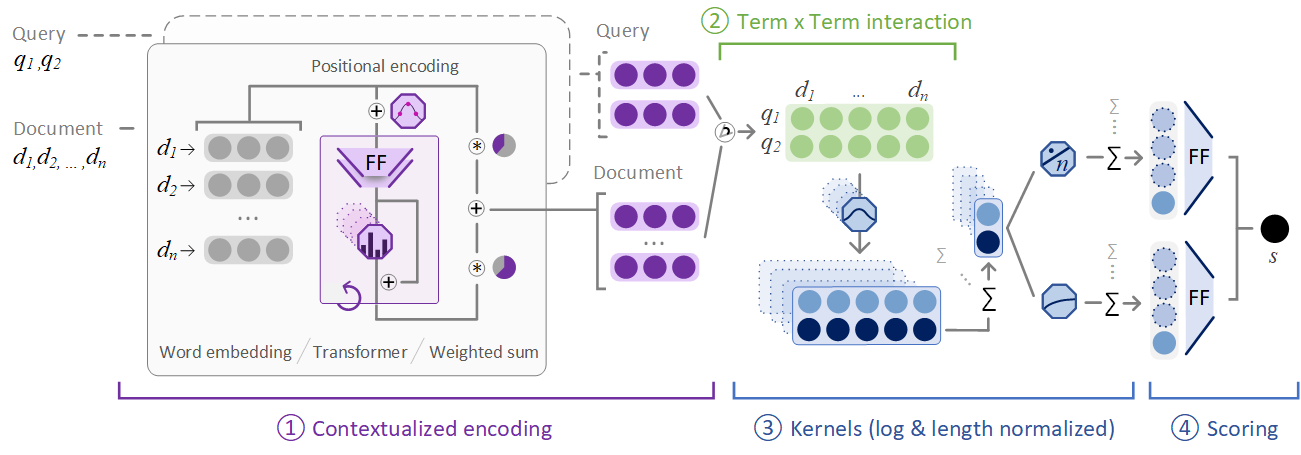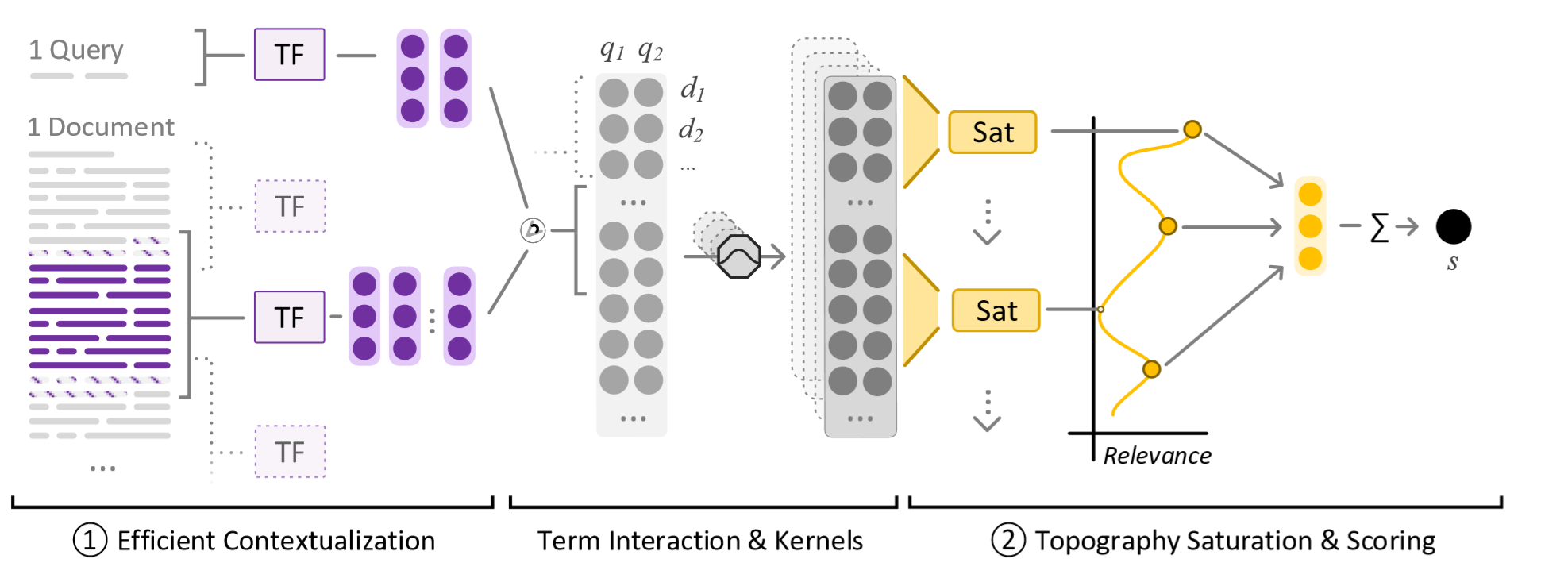This repository is home to the TK and TKL neural re-ranking models. TK is a passage re-ranking model and TKL is an extension for long text (documents).
TK: S. Hofstätter, M. Zlabinger, and A. Hanbury 2020. Interpretable & Time-Budget-Constrained Contextualization for Re-Ranking. In Proc. of ECAI https://arxiv.org/abs/2002.01854
TKL: S. Hofstätter, H. Zamani, B.Mitra, N. Craswell, and A. Hanbury 2020. Local Self-Attention over Long Text for Efficient Document Retrieval. In Proc. of SIGIR https://arxiv.org/abs/2005.04908
We present the TK (Transformer-Kernel) model – inspired by the success of the Transformer-based BERT model and the simplicity of KNRM (Kernel-based Neural Ranking Model). TK employs a small number of low-dimensional Transformer layers to contextualize query and document word embeddings. TK scores the interactions of the contextualized representations with simple, yet effective soft-histograms based on the kernel-pooling technique. Additionally, we enhance kernel-pooling with document length normalization.
The main differences of TK in comparison to BERT are:
- TK’s contextualization uses fewer and lower dimensional Transformer layers with less attention heads. This makes the query-time inference of TK with 2 layers 40 times faster than BERT-Base with 12 layers.
- TK contextualizes query and document sequences independently; each contextualized term is represented by a single vector (available for analysis). BERT operates on a concatenated sequence of the query and the document, entangling the representations in each layer.
- The network structure of TK makes it possible to analyze the model for interpretability and further studies. TK has an information bottleneck built in, through which all term information is distilled: the query and document term interactions happen in a single match matrix, containing exactly one cosine similarity value for each term pair. BERT on the other hand has a continuous stream of interactions in each layer and each attention head, making a focused analysis unfeasible.
The differences of TK to previous kernel-pooling methods are:
- KNRM uses only word embeddings, therefore a match does not have context or positional information.
- CONV-KNRM uses a local-contextualization with limited positional information in the form of n-gram learning with CNNs. It cross-matches all n-grams in n 2 match matrices, reducing the analyzability.
Explore the TK model results in detail with our interactive explorer!
Neural networks, particularly Transformer-based architectures, have achieved significant performance improvements on several retrieval benchmarks. When the items being retrieved are documents, the time and memory cost of employing Transformers over a full sequence of document terms can be prohibitive. A popular strategy involves considering only the first n terms of the document. This can, however, result in a biased system that under retrieves longer documents. In this work, we propose a local self-attention which considers a moving window over the document terms and for each term attends only to other terms in the same window. This local attention incurs a fraction of the compute and memory cost of attention over the whole document. The windowed approach also leads to more compact packing of padded documents in minibatches resulting in additional savings. We also employ a learned saturation function and a two-staged pooling strategy to identify relevant regions of the document. The Transformer-Kernel pooling model with these changes can efficiently elicit relevance information from documents with thousands of tokens. We benchmark our proposed modifications on the document ranking task from the TREC 2019 Deep Learning track and observe significant improvements in retrieval quality as well as increased retrieval of longer documents at moderate increase in compute and memory costs.
If you want to jump straight to the model code: it's here (TK) and here (TKL)!
Please cite TK as:
@inproceedings{Hofstaetter2020_tk_ecai,
author = {Hofst{\"a}tter, Sebastian and Zlabinger, Markus and Hanbury, Allan},
title = {{Interpretable \& Time-Budget-Constrained Contextualization for Re-Ranking}},
booktitle = {Proc. of ECAI},
year = {2020},
}
Please cite TKL as:
@inproceedings{Hofstaetter2020_sigir,
author = {Hofst{\"a}tter, Sebastian and Zamani, Hamed and Mitra, Bhaskar and Craswell, Nick and Hanbury, Allan},
title = {{Local Self-Attention over Long Text for Efficient Document Retrieval}},
booktitle = {Proc. of SIGIR},
year = {2020},
}
- train.py is the main trainer -> it uses a multiprocess batch generation pipeline
- the multiprocess pipeline requires us to do some preprocessing: split the files with preprocessing/generate_file_split.sh (so that each loader process gets its own file and does not need to coordinate)
- Get the msmarco dataset & clone this repository to a pc with 1 cuda device
- Prepare the dataset for multiprocessing:
- Generate the validation sets (BM25 results from Anserini) via matchmaker/preprocessing/generate_validation_input_from_candidate_set.py
- Use
./generate_file_split.sh1x for training.tsv and 1x for the validation set - You have to decide now on the number of data preparation processes you want to use for training and validation (4-6 should do) each file gets one loading process
- The number of processes for preprocessing depends on your local hardware, the preprocesses need to be faster at generating the batches then the gpu at computing the results for them
- Create a new config .yaml in configs/ with all your local paths for train and validation/test files
- The train and validation paths should be the output folder of 2 with a star at the end (the paths will be globed to get all files)`
- Create a new conda env and install the requirements for python 3.7 via conda: pytorch, allennlp, blingfire
- Run
train.pywithpython train.py --run-name experiment1 --config-file configs/your_file.yaml

